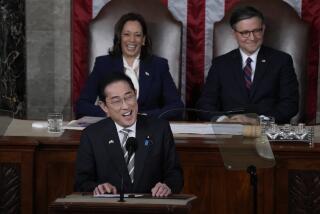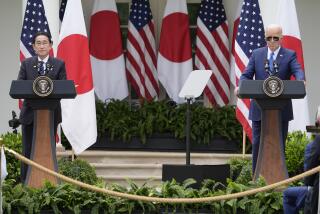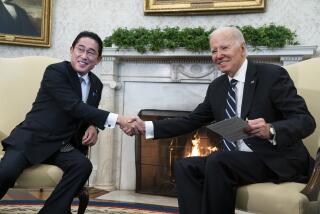Nakasone to Try to Relax Trade Curbs : Promises Reagan ‘Serious Effort’ to Open Japan Markets
Japanese Prime Minister Yasuhiro Nakasone promised President Reagan on Wednesday that he will make a “serious effort” to open up Japan’s markets to more U.S. goods, and both leaders pledged to fight protectionist moves in their countries.
The prime minister promised, in particular, to pave the way for sales of American-made telecommunications equipment when the Japanese telephone system is turned over to private control in April.
Reagan was described by a senior U.S. official as being “greatly encouraged” by Nakasone’s pledges. The official predicted that U.S. companies will see some progress on the lowering of trade barriers by spring.
Arms Talks Discussed
During the three-hour meeting at the Century Plaza Hotel--the fifth between the two leaders--Reagan also briefed Nakasone in great detail, according to the American official, on U.S. strategy for the talks Monday and Tuesday in Geneva between Secretary of State George P. Shultz and Soviet Foreign Minister Andrei A. Gromyko.
Reagan, reading an official departure statement before his return to Washington, said he promised Nakasone “to pursue effective arms-reduction agreements with the Soviets seriously and zealously.”
“I told Prime Minister Nakasone that if the Soviets are prepared to cooperate, then we will make progress,” he said. However, the President again emphasized that “hard bargaining lies ahead.”
Nakasone, in his departure statement, said he expressed respect for Reagan’s “firm determination in the pursuit of peace.”
The bulk of the talks, though, centered on trade problems.
‘Intensified Effort’
Shultz and his Japanese counterpart, Foreign Minister Shintaro Abe, were directed, in Reagan’s words, to “oversee an intensified cooperative effort to make progress in our economic relations.” That apparently met the Administration’s desire, expressed earlier by White House spokesman Larry Speakes, for a series of meetings between key Japanese and American officials “that would get down to brass tacks on these questions of opening up the markets to U.S. trade.”
The U.S. official said the tone of the Reagan-Nakasone meeting was set by the Japanese prime minister, who volunteered that he is keenly aware of the trade problems between the two countries and is determined to solve them. Reagan saw no need to “get tough” with Nakasone, the official said.
Reagan had signaled two weeks ago in Washington that he did not intend to badger Nakasone on trade. Asked by reporters whether he planned to get tough, as some of his advisers had urged, the President replied, “How can I get tough with a very good friend?”
Still, while Reagan--posing with Nakasone for photographs just before the meeting--praised the Japanese for “great progress” on trade, his official spokesman expressed a desire for more concessions.
White House spokesman Speakes said Wednesday that “the bottom line” was that the U.S. government wants to impress upon the Japanese how crucial it is to U.S. economic development that Japan make further trade concessions. If there are none, he continued, “we could certainly come under pressure from Congress” for retaliatory measures protecting U.S. manufacturers from Japanese imports.
Reagan dealt with this in his departure statement, reporting that he and Nakasone had discussed it very candidly.
“We agreed to work strenuously in the months ahead to open our markets fully and to resist protectionist pressures in both countries,” he said. “There is an urgent need to work together.”
A State Department study prepared in October for the Senate Foreign Relations Committee--and leaked last week--charged that moves Japan has announced during the last three years to lower trade barriers have failed to live up to their billing. The report described tariff cuts as too small and having only marginal impact.
The Reagan-Nakasone meeting came at a troubling time for the U.S. government on trade. When final figures for 1984 are in, the United States expects to record a record trade deficit of roughly $125 billion. The trade imbalance with Japan alone is expected to reach $34 billion and grow to more than $40 billion in 1985.
Nakasone, in his statement, said that he and Reagan “shared the determination of making serious efforts for a more balanced development of our trade and economic relations.” He added, “To this end, Japan will promote economic policies that will enhance growth led by domestic private demand and will make further market-opening efforts.”
Reagan, unlike many of his advisers recently, did not publicly point an accusatory finger at Japanese policies. “Our trade deficit, of course, is worldwide due to some of our own economic problems,” he said.
The President apparently was referring particularly to the strong U.S. dollar--caused partly by high interest rates pulling in foreign investments. A strong dollar raises the cost of American goods abroad and makes imports less expensive for U.S. consumers.
Still, U.S. officials have accused Japan of excessive protectionism, including unreasonable tariffs on forest products and fabricated aluminum; extreme standards and certification requirements for such products as medical supplies, and “buy Japanese” policies for telecommunications equipment.
On telecommunications, the official reported, Nakasone promised that his government will “take pains to assure the principle of non-discrimination between Japanese and foreign suppliers and to assure simplicity of standards.”
Later, Nakasone told a press conference, televised live to Japan, that American grievances will be addressed by his government “at the highest level on an issue-by-issue basis” but added that the existing trade imbalance in some ways is already improving.
Nakasone, whose remarks were translated into English for the American reporters present, said there was a 14% increase in U.S. goods exported to Japan in 1984 over the previous year while Japanese exports have been on the decline. He pointed specifically to what he said were a 36% increase in computer sales and a 55% increase in semiconductor sales by U.S. firms to Japan. “I intend to encourage such trends,” he promised.
On other questions of joint interest between the two nations, Nakasone told his audience back home that he has been assured by Reagan that the United States would consult with Japan before a proposed “Star Wars” umbrella against nuclear missiles--known formally as the Strategic Defense Initiative--is deployed in space. He said the President “does not intend to use SDI as a tool for bargaining with the Soviet Union”.
Asked about criticism in some American quarters that Japan has been slow to assume its rightful share of defense costs, the prime minister said his nation spends $1 billion annually to help pay for U.S. troops stationed in Japan. He called that figure “a considerable sum,” adding, “In recent years, Japan’s efforts in this field have been far greater than the NATO (North Atlantic Treaty Organization) countries.”
He said a 6.55% increase in Japanese defense expenditures in 1984, coupled with a planned 6.9% boost this year, “represents a bold effort on our part to increase our defense capabilities.”
Times staff writer Michael Seiler contributed to this story.
More to Read
Sign up for Essential California
The most important California stories and recommendations in your inbox every morning.
You may occasionally receive promotional content from the Los Angeles Times.











